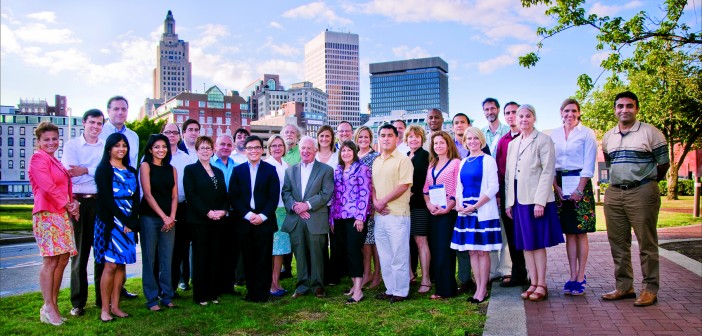A new master’s program creates leaders.
With a professional career already underway, many leaders in health care might not think about going back for another degree. But as health care delivery becomes more complex and collaboration more crucial, many providers, executives, and other professionals feel the need to gain new skills and a better understanding of health care reform. That has them flocking to Brown’s Executive Master of Healthcare Leadership (EMHL) program.
Program Director Angela Sherwin ’07 MPH’09 says the program was “overwhelmed” by interest. Twenty eight students are enrolled in the first cohort of the program, which began in August 2013. They have professional roles all over the health care industry, as physicians, pharmacists, hospital and patient care practice executives, health insurers, IT experts, and even a health care architect and facility planner. But they share the same goal: learn up-tothe- minute best practices in the rapidly changing health sector.
Doreen Wiggins MD’88 RES’92 decided to pursue the degree program when she was appointed founding director of the Women’s Cancer Survivorship Program at Lifespan. The breast surgeon wanted to get things right from the start, and saw the degree program would give her the skills to do that. “One of the things we’re looking at [in the coursework]is the cost effectiveness of the things we do for patients and whether they align with evidence-based medicine. We’re asking, is it an effective treatment and is it cost effective?” Wiggins says.
Because the curriculum of the EMHL is designed to address real-world problems, students identify a “critical
challenge” they are facing in their organization. All of their coursework and their final project are focused on learning ways to address that challenge. They develop a strategic plan that can be implemented in their workplace. For Assistant Professor of Emergency Medicine Anthony Napoli, MD RES’06, that’s the emergency department (ED).
“My critical challenge focuses on more efficient and effective management of patients who present to the ED with undifferentiated illnesses or diagnoses that may be best managed in a short-stay clinical decision unit,” Napoli says. “Rapid diagnostic and management protocols in such units offer the capacity to provide improved patient care, at lower cost, with lower resource utilization and with greater patient satisfaction.”
Both Wiggins and Napoli say the perks of the program so far have been the teamwork and the exposure to different aspects of the health care industry.
“The program provides different ways of thinking about the work we do. You learn about marketing, strategic planning, and how to read data,” Wiggins says. “It promotes forward thinking.”
At the end of the 16-month program (the first cohort will finish this fall and participate in the May 2015 Commencement), the students will emerge as true leaders, not only ready to face the fluctuations underway, but to make change themselves.
“There’s a passion for transformation in our students,” Sherwin says. “I’m excited to see what they’ll accomplish in the next few years.”




